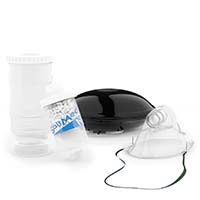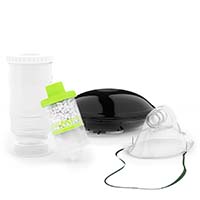
Allergic rhinitis / hay fever
Allergic rhinitis, also known as hay fever, is manifested by an inflammatory reaction in the mucosa of the nose that occurs upon its contact with certain allergens: pollen, chemicals in the atmosphere, cigarette smoke, etc. The patient with hay fever has the sensation of a stuffy nose and as a result may breathe with difficulty.
Allergic rhinitis symptoms
In the case of allergic rhinitis (hay fever), the most common symptoms are:
- repeated sneezing, especially in the morning, upon waking up
- runny, stuffy or itchy nose
- a sore or scratchy throat
- itchy or watery eyes
- frequent headaches
Nasal secretions that drain on the posterior walls of the throat can cause a sore or scratchy throat or trigger a chronic irritant cough.
SaltMed – natural treatment in allergic rhinitis / hay fever
The therapy with dry microparticles of salt with controlled characteristics works in patients with allergic rhinitis as follows:
- Once deposited on the inflamed and edematous respiratory mucosa, salt absorbs water through a simple osmotic process. Water absorption has the effect of decreasing edema and thereby unblocking the airway.
- Studies also show that, following salt treatment, there is a decreased sensibility to allergens and increased local immunity to bacterial infections.
Benefits of using SaltMed in patients with allergic rhinitis / hay fever
- Decreased edema and removed the sensation of stuffy nose
- Using the SaltMed saline inhaler for a longer period of time, decreases sensitivity to allergens and thus the inflammatory reaction in the presence of allergens no longer occurs
- Prevents acute respiratory infections that usually aggravate allergic rhinitis.
SaltMed can be used safely by patients with heart and kidney disease because the salt is not absorbed into the bloodstream from the lung.
There is no risk of overdose with SaltMed therapy and there are no interactions with other drugs. SaltMed therapy for allergic rhinitis (hay fever) is performed as an adjunct to the therapy prescribed by the doctor.
People diagnosed with atrophic rhinitis does not benefit from SaltMed therapy.
How to use SaltMed in patients with allergic rhinitis / hay fever
We recommend to use SaltMed for one and a half hours a day during the first two weeks of treatment, then reduce this to one hour a day.
Ideally, you should not encounter allergens during therapy, but this is difficult to achieve. For this reason, may not be easy to specify the exact duration of treatment. Although the benefits are observed from the first weeks of therapy, at least 4 months of treatment are recommended to achieve a steady effect of decreased sensitivity to allergens.
In allergic rhinitis (hay fever), N or L type SaltMed cartridges can be used.

Testimonials

Catalina Mariana Botea
SaltMed has helped me a lot in respiratory and allergic diseases, the recovery period being shorter and the symptoms visibly alleviated by its use. It's worth a try, especially in the season of the viroses.
Order your SaltMed salt dry inhaler now

SaltMed Inhaler type N

